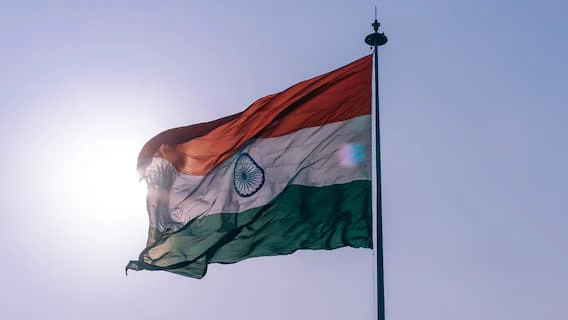India is preparing to celebrate its 79th Independence Day on August 15, 2025, and the capital city, Delhi, becomes a center of patriotic fervour.
The tricolour flies high over monuments, streets, and homes, and cultural events and processions celebrate the nation’s path to freedom.
From majestic Mughal forts to dignified memorials of national leaders, these places tell the tale of India’s struggle, sacrifices, and achievements. Here are some of the most important historical sites in Delhi to visit during Independence Day.
Red Fort:
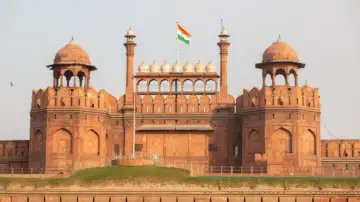 (Image Source: Canva)The Red Fort is the symbol of India’s Independence Day celebrations, with the Prime Minister raising the national flag here every year since 1947. Constructed in the 17th century by Mughal Emperor Shah Jahan, this UNESCO World Heritage Site is a red sandstone masterpiece that combines Persian, Timurid, and Indian architectural styles. On Independence Day, the fort is filled with patriotic fervour, security deployments, and large numbers of tourists willing to see history being made.
(Image Source: Canva)The Red Fort is the symbol of India’s Independence Day celebrations, with the Prime Minister raising the national flag here every year since 1947. Constructed in the 17th century by Mughal Emperor Shah Jahan, this UNESCO World Heritage Site is a red sandstone masterpiece that combines Persian, Timurid, and Indian architectural styles. On Independence Day, the fort is filled with patriotic fervour, security deployments, and large numbers of tourists willing to see history being made.
India Gate:
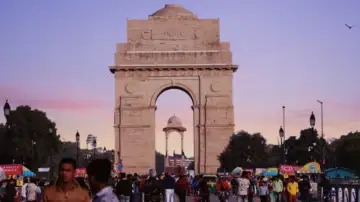 (Image Source: Canva)Soaring above the city of Delhi, India Gate is not just a monument; it’s a war memorial to the lives of more than 70,000 soldiers of the British Indian Army who sacrificed themselves during World War I. During Independence Day, the monument is lit up magnificently, while Amar Jawan Jyoti, the perpetual fire, burns in honour of soldiers who sacrificed their lives for the country. The green lawns surrounding India Gate are turned into a vibrant spot for families, picnics, and patriotic functions.
(Image Source: Canva)Soaring above the city of Delhi, India Gate is not just a monument; it’s a war memorial to the lives of more than 70,000 soldiers of the British Indian Army who sacrificed themselves during World War I. During Independence Day, the monument is lit up magnificently, while Amar Jawan Jyoti, the perpetual fire, burns in honour of soldiers who sacrificed their lives for the country. The green lawns surrounding India Gate are turned into a vibrant spot for families, picnics, and patriotic functions.
Rashtrapati Bhavan:
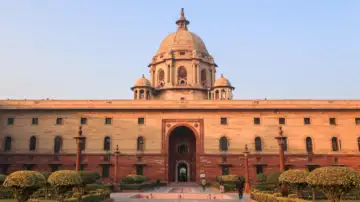 (Image Source: Canva)Rashtrapati Bhavan, the official residence of the President of India, is an architectural wonder and symbol of governance. Commissioned by Sir Edwin Lutyens in the British time, it has 340 rooms on an area of 320 acres, making it one of the largest private residences of any head of state in the globe. The lit facade of the building, ceremonial sentries, and sprawling Mughal Gardens provide a treat to the eye. This monumental complex symbolises both the colonial legacy and the democratic development of the nation after 1947.
(Image Source: Canva)Rashtrapati Bhavan, the official residence of the President of India, is an architectural wonder and symbol of governance. Commissioned by Sir Edwin Lutyens in the British time, it has 340 rooms on an area of 320 acres, making it one of the largest private residences of any head of state in the globe. The lit facade of the building, ceremonial sentries, and sprawling Mughal Gardens provide a treat to the eye. This monumental complex symbolises both the colonial legacy and the democratic development of the nation after 1947.
Raj Ghat:
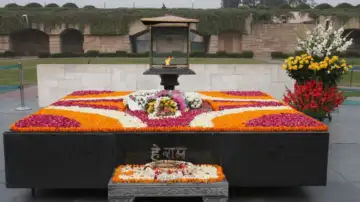 (Image Source: Pinterest/ mayurabcn)Raj Ghat is where Mahatma Gandhi rests in peace. Surrounded by landscaped gardens, fountains, and serene pathways, Raj Ghat is a space of quiet reflection, a stark contrast to the festive bustle of Independence Day. Here, visitors can pause to remember Gandhi ji’s philosophy of non-violence and his pivotal role in securing freedom. Strolling through its tranquil surroundings enables one to ponder over the principles that moulded the fate of the nation.
(Image Source: Pinterest/ mayurabcn)Raj Ghat is where Mahatma Gandhi rests in peace. Surrounded by landscaped gardens, fountains, and serene pathways, Raj Ghat is a space of quiet reflection, a stark contrast to the festive bustle of Independence Day. Here, visitors can pause to remember Gandhi ji’s philosophy of non-violence and his pivotal role in securing freedom. Strolling through its tranquil surroundings enables one to ponder over the principles that moulded the fate of the nation.
Gandhi Smriti:
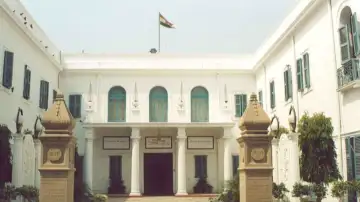 (Image Source: Pinterest/ exoticvishnu)Gandhi Smriti is of great emotional and historical importance as the place where Mahatma Gandhi passed his last days and was assassinated on January 30, 1948. The house has been kept intact as a memorial, with photographs, personal items, and displays recounting his life and activities. The Martyr’s Column designates the very spot where he was killed. Gandhi Smriti is a sombre spot on Independence Day to reflect on his ideals of peace, harmony, and simplicity.
(Image Source: Pinterest/ exoticvishnu)Gandhi Smriti is of great emotional and historical importance as the place where Mahatma Gandhi passed his last days and was assassinated on January 30, 1948. The house has been kept intact as a memorial, with photographs, personal items, and displays recounting his life and activities. The Martyr’s Column designates the very spot where he was killed. Gandhi Smriti is a sombre spot on Independence Day to reflect on his ideals of peace, harmony, and simplicity.
National Museum:
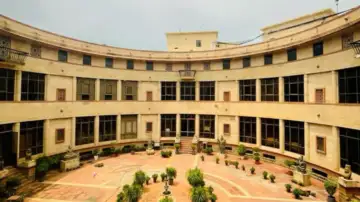 (Image Source: Pinterest/ akshitaeu)The National Museum is a treasure house for anyone interested in learning about India’s long and varied past, particularly its struggle for independence. Exhibits featuring freedom fighters such as Subhas Chandra Bose, Bhagat Singh, and Jawaharlal Nehru bring to life the determination and bravery that forged modern India. A visit to the museum on Independence Day presents a multi-layered experience, from appreciating the greatness of ancient civilisations to reliving the highlights of 20th-century freedom.
(Image Source: Pinterest/ akshitaeu)The National Museum is a treasure house for anyone interested in learning about India’s long and varied past, particularly its struggle for independence. Exhibits featuring freedom fighters such as Subhas Chandra Bose, Bhagat Singh, and Jawaharlal Nehru bring to life the determination and bravery that forged modern India. A visit to the museum on Independence Day presents a multi-layered experience, from appreciating the greatness of ancient civilisations to reliving the highlights of 20th-century freedom.
